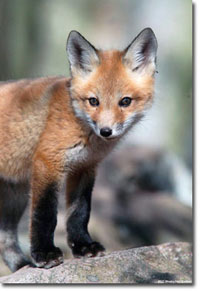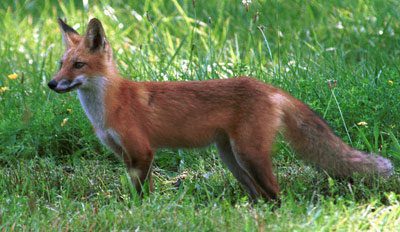The Red Fox
(Vulpes vulpes)
 Description & Range:
Description & Range:
The red fox is found in North America from the Arctic Circle to well into
Central America. It has a slender body, long legs, a slim muzzle, upright
triangular ears and a bushy tail, usually tipped in white. Gray foxes can also
be found in Maryland, and they tend to have a black tipped tail. Gray foxes also
tend to be smaller than red foxes.
Habitat:
Ideal red fox habitat includes a mix of open fields, small woodlots and
wetlands – making modern-day Maryland an excellent place for it to live. Red
foxes are also highly adaptive and can be found in suburban and urban areas.
While native to Maryland, there are reports of early settlers bringing the red
fox from Europe for release by landowners for hunting with hounds.
Diet:
Red foxes have an omnivorous diet, meaning that they eat both plants and
animals. A typical red fox diet includes rabbits, snakes, insects, birds, mice,
berries and fruits.

Reproduction:
The red fox usually uses a den or burrow only during the period when it is
raising pups – a task the male and female fox share together. Red foxes mate
from January through March. After a gestation period of 51 to 53 days, females
give birth to a litter averaging 4 or 5 pups in the spring. Red foxes may dig
their own burrows, but they usually improve an abandoned groundhog burrow. It
also is common for foxes to den in the crawl space under decks and sheds. During
the remainder of the year, the red fox avoids dens and sleeps in sheltered
locations by relying on its thick fur for warmth.
Sounds
Foxes can be quite vocal, and they make barks, howls, and whines. The sounds
vary from a short, sharp "yap" or bark, followed by a "yap, yap," to a combination of screeches, yells, and long howls.
Behavior
While its cousins the wolf and dog are social, the red fox tends to be more
solitary except during the breeding season. The red fox is capable of learning
from experience, which has earned it the “cunning” namesake in literature. This clever nature, its adaptability and careful management, ensure that the red fox will roam the Chesapeake Bay watershed for many generations to come.
Click here to learn more about furbearer management in Maryland.
Photo of red fox pup courtesy of Hal Korber/Pennsylvania Game Commission
Photo of adult red fox in meadow, courtesy of Pennsylvania Game Commission